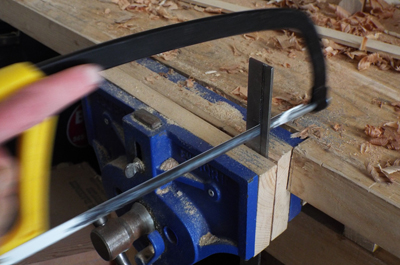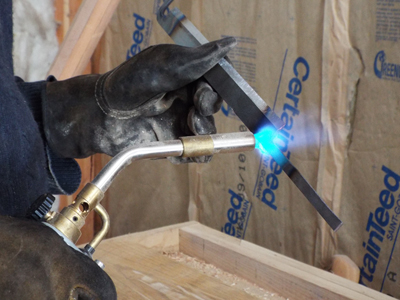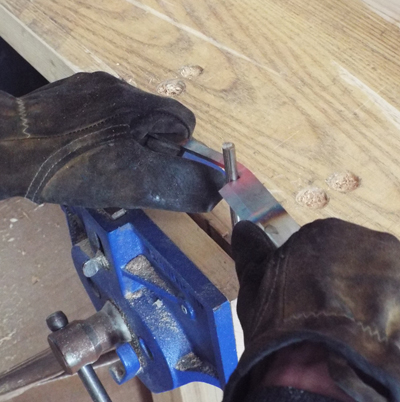|
It's a fact that from time to time the right tool just can't be found. Maybe the chisels available just
aren't the right size to cut the necessary mortise, or the handle on your scorp bumps against the
edge of your Windsor chair seat as you attempt to shave a smooth, fair hollow. Or perhaps, despite
the wonderful revival in handtool craftsmanship of late years, the needed tool isn't available on
the market, or you need it before UPS can get it to your door.
I suggest an alternative to throwing up one's hands in exasperation and leaving the project
unfinished for another day. The clever woodworker, with a few basic tools, many of which are
probably already on hand, can become a metalworker, and make or modify many simple tools.
This approach offers all kinds of advantages. Shopmade tools are sometimes more affordable than
their hardwarestore counterparts, and often of equal or better quality, not to mention being
customized to the job at hand.

|
Sawing out the tang on a small drawknife. The offcut will be used
to make a marking knife.
|
This sort of practical, jackofalltrades attitude is far from new. In fact, the ability to make or
modify basic tools was commonplace only a generation or two ago in American workshops and on
American farms. The ability to tap threads, saw through steel, forge weld, and and grind new edges
on old tools saved many a lengthy trip to town or costly delay in a project. I believe that this
approach is just as beneficial today as it was in times past, and making tools is fun! Few things are
more satisfying than using a tool that you have made to make something new, and before long you
may even find yourself using a tool that you have made to make another tool.
Chances are good you may already have a drill press, lathe, bench grinder, machine vise, and
belt/disc sander in your shop. Add a small propane or MAPP gas torch and a good quality hacksaw
to these, and you have the capability to make or modify many common tools. The basic procedures
of sawing, grinding, bending, drilling, and polishing steel are all that are needed to make many
hand tools.

|
|
Grinding the drawknife bevel. Note the shop-modified grinding jig.
|
A basic knowledge of tool steel is important to understanding how this process works. There is a
dizzying variety of alloy steels available, only a few of which are relevant to the woodworker. At
its most basic, a high carbon steel, that is, a steel with a relatively high proportion of carbon to iron
content, has the capacity for hardness that is needed in a cutting edge. This kind of steel can be
found as scrap in many steels that are used for cutting, or in load bearing operations. Leaf springs,
lawnmower blades, old garden shears, and bed frames all offer sources of high carbon steel that
can hold a good cutting edge. Additionally, 01 tool steel in dimensional stock is available from
many suppliers, and is a convenient source of tool steel at a reasonable price.

|
|
Heating a tang for bending.
|
Steel is generally worked most easily when it is in its soft, or annealed, state. Dimensional tool
steel stock is often sold annealed, but salvaged steels will have to be annealed before being
worked. I generally accomplish this by placing the piece deep in the redhot coals at the bottom of
my woodburning stove, and allow it to gradually reach critical heat and then cool there. On the
morning of the next day, I retrieve the piece from the ashes and get to work. If you don't have a
woodstove in your home or shop, this can also be achieved in a small campfire, or by heating the
piece redhot with a torch and burying it in sand or ash.

|
Bending the drawknife tang around a steel rod. Leather gloves may
not always be sufficient to protect your hands from the heat,
so work carefully!
|
To hold a good cutting edge without being so brittle that it shatters under stress, steel must be
tempered properly. This process is often perceived as mysterious knowledge held only by master
blacksmiths, but in fact it is a straightforward procedure. The details of the process go beyond the
scope of this article, but there are many excellent materials in print that cover the subject. I assure
you that with a bit of determination and the assistance of a good book, you can master hardening
and tempering!
As in all shop endeavors, safety cannot be stressed strongly enough. Wood shops tend to be full of
shavings and sawdust, which mix all too well with the hot sparks from grinding steel. Red hot steel
will certainly leave a mark in the unfortunate event of it contacting your skin. Similarly, tiny bits
of steel encountering your eye will be an experience to remember for a long time to come. The
stakes are high here, ranging from permanent personal injury to a catastrophic fire in your shop. I
insist that if you are going to pursue making and modifying your own tools (and I hope that you
do), you research and follow all safety procedures.
There are many good blacksmithing and toolmaking books in print that will cover these processes
in detail. I can personally speak of three, which I cannot recommend highly enough.
Making Wood
Tools with John Wilson
, by John Wilson, is a relatively recent publication covering tool projects
from a travisher to a smooth plane.
The Complete Modern Blacksmith
, actually a compilation of
three books, by Alexander G. Weygers, offers a near complete treatment on making tools from
salvaged steels, and setting up a shop in which to do so. Finally,
Making Hand Tools
by the
boatbuilder Harry Bryan describes in detail a dozen or so boatbuilding related tool projects, from a
boatbuilder's slick to a bench vise. Any one of these books will offer the fledgling toolmaker a
great introduction to the subject, and between the three of them, you will have projects and ideas
for years to come.
Toolmaking is a grand adventure, and opens to the door to possibility previously unknown. I hope
you find in it the excitement and satisfaction that I have.
Kerry trained as a boatbuilder. He now builds furniture and teaches woodworking skills at various gatherings and folk schools. He has a particular passion for hand work and efficient use of hand tools, and enjoys designing and building items of day-to-day necessity. You can email Kerry at
k_lambertson@yahoo.com
.
Return to
Wood News
front page
|





